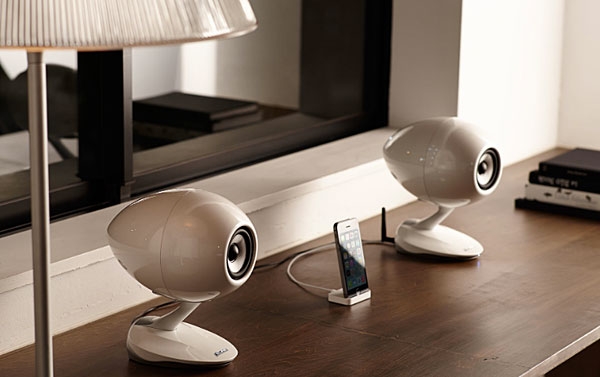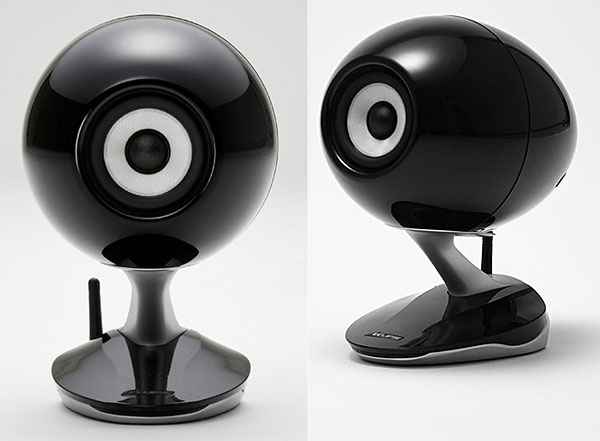| Columns Retired Columns & Blogs |
Listening #149

At home, I have two different ways of listening to music—just as I have two different ways of cooking and washing the car and making coffee and getting dressed to go out.
My first approach to listening is the one that takes the most time: It requires forethought and effort and, consciously or not, a certain amount of ritual—yet those things are enjoyable in and of themselves, and the end results are often more than merely satisfying.
My other approach is the one I take when there's a piece of music I'm intent on hearing right away, and I have a limited amount of time and no inclination toward effort.
My record collection and my playback system—the latter with its different tonearms for different pickups and different pickups for different records and different amplifiers for different moods—are perfectly suited for the first kind of listening. But they make a mockery of my efforts toward the second kind.
Consequently, although I'm thankful for the good fortune of owning such nice things, I continue to look fondly on that too-brief time when my modest record collection was divided between 12" LPs and 7" 45rpm singles, and when my system was the family's Webcor portable record player, which I schemed to keep in my room as much of the time as possible. It seems to me now that I had quick, easy access to the music I loved, and the experience was almost always great. What happened?
I had more hair, too
The catalyst for those musings is the Eclipse TD-M1 powered loudspeaker ($1300/pair), which Michael Lavorgna reviewed for our sister site Audiostream.com. To the person with a collection of music files and a suitable device through which to stream them, the Eclipse TD-M1, designed and made by Japanese manufacturer Fujitsu Ten, is a more or less complete hardware solution. It comprises an onboard digital preamplifier and amplifier; an onboard D/A converter capable of 24-bit/192kHz performance with music streamed through its USB input; and onboard WiFi, for 16/44.1 wireless streaming via Apple AirPlay.
The TD-M1 is built around a proprietary 3" driver with a synthetic-fiber cone, a fabric dustcap, and a compliant surround. Its substantial and rather intricate alloy frame is designed to hold the driver rigidly within a molded exoskeleton, the latter intended to prevent the formation of standing waves within and high-frequency reflections without, and formed with a rearward reflex port. The resulting shape of the enclosure is not unlike that of a cartoon wolf's eyes when they zoom from their orbits and stretch, to impossible limits, their optic nerves and rectus muscles.

Each eye or egg or whatever you want to call it is fastened to its base by means of a metal strut with some measure of articulation; vertical tilt can be set for one of three positions, then locked in place with a cam-clamp of the type used on modern steering-wheel columns—a nod, perhaps, to Fujitsu Ten's work in the automotive field. Tilted fully upward, there is something compelling, even cute about the TD-M1, the stance of which suggests an appliance ready to please. It looks almost human, as long as your definition of human includes such descriptors as hairless and monocular. Mine certainly does.
The base of one TD-M1 per pair—the one designated for the right channel—contains a 20Wpc digital amplifier and other electronics, and its rear panel is fitted with connectors for a WiFi antenna, USB Type A and Type B connectors, a 3.5mm jack for a line-level analog input, and an inline jack for the system's external AC adapter, itself bigger and nicer looking than the average wall wart. A nonremovable cable, just under 5' long, carries the amplified music signal to a 3.5mm input jack on the base of the left-channel speaker.
TD-M does not spell tedium
After it arrived at my home, the Eclipse TD-M1 system was installed by Philip O'Hanlon, of Eclipse's US distributor, On a Higher Note, who was then traveling through the Northeast. Unfortunately, we chose for the TD-M1 a portion of my family's outsize dining-room table, and it wasn't long before social obligations forced me to dismantle the system and set it to one side, prior to setting it up on my desk a couple of weeks later. Fortunately, installation wasn't at all daunting, and the instruction manual is about as good as one can expect: comprehensive, clear, and laudably free of unnecessary jargon, the likes of which strike fear in the hearts of the impatient.
It seemed that the TD-M1's soft-touch controls, which are also built into the right-channel speaker, were designed to remain inconspicuous when not in use. They succeeded at that, but they also made themselves rather too scarce when they were in use. A concealed strip for adjusting volume, designed to respond to taps or side-to-side swipes, was imprecise, and often produced the opposite of the desired effect before changing course. And the source-selector switch, which is also the main power switch—holding down the button for different amounts of time enables different functions—is unlabeled, so the user must memorize the toggling order of the four available sources: AirPlay, USB B, USB A, and Aux (line-level analog). Such tasks were made easier by the Eclipse TD-M1 app, available free of charge from the iTunes App Store, and which also gives the user the ability to disable the system's digital filter, a function not found on the TD-M1 itself. Those mildly impractical controls were the only fly in this ointment; otherwise, once I became accustomed to its way of doing things, the TD-M1 was easy to use.
After connecting the Eclipse system to my iMac with a USB cable of the usual sort, setup was a simple matter of opening the Apple's System Preferences window and selecting "Eclipse TD-M1" from the Sound menu—which is to say, it was as simple as hooking up any USB DAC. Within just a few minutes, I was enjoying files from my iTunes library.
No less intuitive was the TD-M1's wireless function. For Christmas, my wife and daughter gave me an Apple iPhone 6 Plus—also good for eyes that have been stretched to the limit—and it took less than a minute to bring up the iPhone's Control Center, switch on AirPlay, and select "Eclipse TD-M1." I asked my daughter to bring in her own iOS 8–equipped iPhone; with minimal guidance and in about 20 seconds, she was streaming Vampire Weekend and St. Vincent and the Black Keys through the TD-M1s.
And they sounded fine! The files on my daughter's iPhone are mostly MP3s, while those on my own phone are mostly AIFF files ripped from CDs in my collection. In AirPlay mode, the Eclipse TD-M1 was candid about the distinctions between those and other file types, but not rudely or ruthlessly so. MP3s sounded grainier than AIFFs, and AIFFs sounded a bit chalkier than they do when streamed to my Halide DAC HD and played through my big system. Yet in every case, digital files streamed wirelessly to the Eclipse TD-M1 exhibited more momentum and flow, and were far more involving, than they had any right to be.
Part of that had to do with the TD-M1's tonal balance and spatial attributes. For lack of a better word, and for reasons I can't begin to fathom, listening to the Eclipse system reminded me of listening to headphones—but headphones that everyone could hear, that didn't make me feel as if I were in an isolation tank, and that didn't make my ears itch or hurt. (God, I despise headphones.) I wondered, more than once, if the TD-M1 has some sort of built-in, Fletcher-Munson–style loudness correction: Regardless of volume setting, music played through this desktop system always sounded rich, big, and uncannily right. It was almost creepy. But good creepy.
And while my big system, with its powerful Garrard 301 turntable at one end and a pair of Shindo-driven Altec horns at the other, obviously bettered the TD-M1 in any performance aspect you could name, the Eclipse system was nonetheless successful at the most important thing of all: It got me all wrapped up in whatever music I happened to be playing. I got misty during Nick Cave's "Far from Me," considerably more than misty during Nick Drake's "Fruit Tree," cloud-nine happy during John Lennon's "Instant Karma," and righteously outraged during the Rolling Stones' "Street Fighting Man." I had a great time with this system whenever I used it—and it was always easy.
It isn't every day that I make coffee by grinding the beans by hand and bringing the water to the precisely correct temperature (never boiling!). And some days, a drive in the car is nothing more than a way to get to the post office and back, and never mind that I haven't cleaned the brake calipers for a couple of months. Similarly, on some days I'm less interested in unearthing colors and textures and sensations from the grooves of my LPs than I am in simply hearing Pink Floyd's "See Emily Play" right now—or Procol Harum's recently unearthed "Understandably Blue," or the fiddle tunes Clarence White recorded for his guitar students, or a few cuts off that 1962 Dylan bootleg from the Finjan Club, in Montreal. There is ritual, and then there is easy access; assuming each is done well, I enjoy having both.
- Log in or register to post comments




































